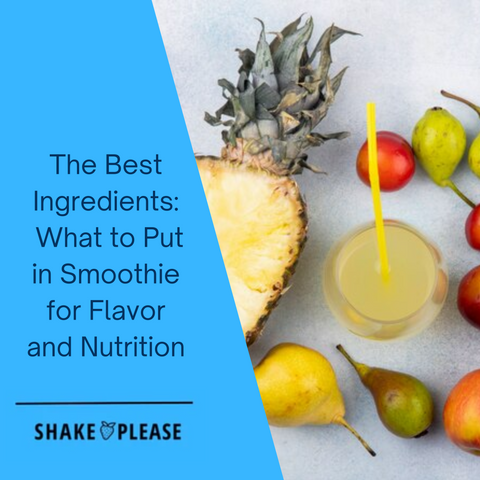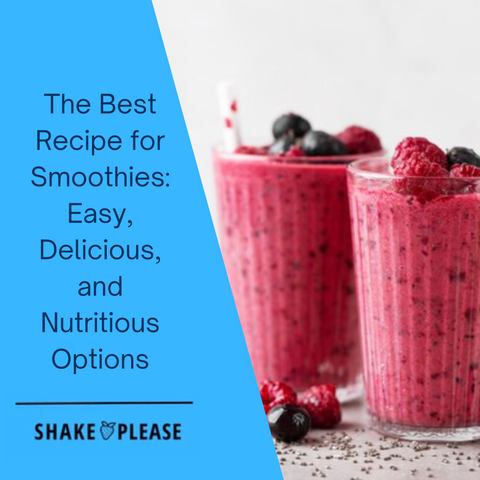
Choosing the Right Frozen Fruit
Fruits and veggies are the foundation of a smoothie recipe for a delicious and nutritious drink. Here’s how to make a smoothie with the best choices:
-
Frozen Fruits for Creaminess
-
Use frozen strawberries, blueberries, and raspberries to create a thick, creamy texture.
-
Frozen fruits also eliminate the need for additional ice, keeping flavors concentrated.
-
Creative Fruit Combinations
-
Mix tropical fruits like mango, pineapple, and banana for a sunny, refreshing blend.
-
Combine berries and bananas for a classic, naturally sweet combination.
-
Experimenting with different fruit combinations can help you create a unique smoothie recipe that suits your taste preferences.
-
Fresh Fruits for Lightness
-
Add fresh fruits like apples or berries for a lighter, crisp smoothie.
-
Fresh fruits work well when paired with a base like coconut water or almond milk.
-
Juice for an Extra Burst of Flavor
-
Use fruit juices like orange juice or mango juice sparingly to amplify flavor without overwhelming sweetness.
Fresh Fruit Options
When it comes to making a smoothie, fresh fruit is a fantastic option to consider. Fresh fruit adds natural sweetness, vibrant flavor, and a delightful texture to your smoothie. Some popular fresh fruit options for smoothies include:
-
Berries: Strawberries, blueberries, raspberries, and blackberries are all excellent choices.
-
Citrus Fruits: Oranges, grapefruits, and lemons can add a zesty kick.
-
Apples: A great way to add a crisp, refreshing taste.
-
Bananas: Perfect for adding creaminess and natural sweetness.
-
Avocados: For a creamy texture and healthy fats.
Keep in mind that using fresh fruit can make your smoothie more watery, so it’s best to balance it out with a frozen banana or a cup of ice cubes.
Frozen Fruit Benefits
Frozen fruit is a great option for smoothies because it’s convenient, affordable, and just as nutritious as fresh fruit. Here are some benefits of using frozen fruit in your smoothies:
-
Convenience: Frozen fruit is already washed, chopped, and ready to use, saving you prep time.
-
Affordability: Frozen fruit is often cheaper than fresh fruit, especially for out-of-season varieties.
-
Nutrition: Frozen fruit is just as nutritious as fresh fruit, as it’s picked at the peak of ripeness to preserve its nutrients.
-
Texture: Frozen fruit adds a thick and creamy texture to your smoothie, eliminating the need for additional ice.
The Secret to Refreshing Smoothies with Frozen Fruit
Some popular frozen fruit options for smoothies include:
-
Berries: Strawberries, blueberries, raspberries, and blackberries.
-
Mango: Adds a tropical sweetness.
-
Pineapple: For a refreshing, tangy flavor.
-
Peaches: A sweet and juicy addition.
-
Bananas: Perfect for a creamy base.
Adding Creaminess and Protein with Greek Yogurt
To create a satisfying and nutrient-rich smoothie, focus on creamy additions and protein-packed ingredients:
-
Greek Yogurt for Texture and Tang
-
Greek yogurt adds richness, a hint of tanginess, and protein to your smoothie.
-
It’s an excellent base for shakes with berries or citrus fruits.
-
Incorporating Greek yogurt into your smoothie recipe can add a rich texture and boost protein content.
-
Dairy-Free Alternatives
-
Use almond milk or coconut milk for a creamy, plant-based option.
-
These alternatives complement tropical flavors like pineapple or mango.
-
Nut Butters for Healthy Fats
-
Add a spoonful of almond butter or peanut butter for creaminess and a nutty taste.
-
Nut butters pair wonderfully with bananas, cocoa, or berries.
-
Protein Boost with Protein Powders
-
Incorporate whey to meet your daily protein goals.
-
Use unflavored or vanilla protein powder for versatility or chocolate protein powder for indulgence.
Essential Smoothie Ingredients
When it comes to making a smoothie, there are a few essential ingredients you’ll want to include. Here are some of the most important ones:
-
Frozen Fruit: Adds natural sweetness, flavor, and a creamy texture to your smoothie.
-
Liquid Base: This can be milk, yogurt, or a non-dairy alternative like almond milk or coconut milk.
-
Protein Source: Options include Greek yogurt, protein powder, or nuts and seeds like almonds or chia seeds.
-
Healthy Fats: Avocado, nuts and seeds, or healthy oils like coconut oil or almond butter.
Liquid Bases
The liquid base of your smoothie is what gives it its creamy texture and helps to blend all the ingredients together. Here are some popular liquid base options:
-
Milk: Dairy or non-dairy alternatives like almond milk, soy milk, or coconut milk.
-
Yogurt: Greek yogurt or regular yogurt for added creaminess and protein.
-
Juice: Fruit juice like orange juice or mango juice for a burst of flavor.
-
Water: Use water as a base if you want a lighter smoothie.
Try These Ready-to-Drink Smoothies
Save time while enjoying perfectly blended smoothies packed with nutrition:
-
Vanilla Berry Protein Smoothie: A creamy, protein-rich option with berries and vanilla. 👉 Discover Vanilla Berry Protein Smoothie
-
Strawberry Banana Protein Smoothie: A classic, sweet, and satisfying blend. 👉 Try Strawberry Banana Protein Smoothie
These ready-to-drink options are perfect for those who want a quick and easy smoothie recipe without the hassle of preparation.
By choosing the right fruits and incorporating creamy, protein-rich ingredients, you can create smoothies that are both delicious and nutritious. Experiment with different combinations to discover your perfect blend!
Boosting Nutrition with Chia Seeds
-
Chia Seeds or Flax Seeds
-
Add chia seeds or flax seeds to your smoothie for a slightly nutty flavor and seedy texture.
-
These seeds are rich in omega-3 fatty acids and fiber, promoting heart health and digestion.
-
Including chia seeds or flax seeds in your smoothie recipe can significantly enhance its nutritional profile.
-
Leafy Greens Like Spinach
-
Use fresh spinach for a green smoothie that’s mild in taste yet packed with antioxidants, iron, and vitamins A and C.
-
Pair spinach with tropical fruits like mango or pineapple for a naturally sweet and nutrient-dense blend.
-
Cocoa Powder for Antioxidants
-
Add unsweetened cocoa powder to create a rich, chocolatey flavor while boosting your smoothie with powerful antioxidants. For a quick, healthy meal option, try the Chocolate Peanut Butter Banana Protein Smoothie.
-
Mix with banana and almond milk for a creamy, dessert-like treat.
-
Protein-Rich Additions
-
Enhance your smoothie with nutrient-dense ingredients like nuts, seeds, or nut butter.
-
These ingredients provide a healthy dose of protein, fats, and minerals for sustained energy.
High Fiber Options
Adding high fiber ingredients to your smoothie can help to keep you full and satisfied. Here are some high fiber options you can add to your smoothie:
-
Chia Seeds: These tiny seeds are packed with fiber and omega-3s.
-
Flax Seeds: High in fiber and omega-3s, they add a slightly nutty flavor.
-
Avocado: This fruit is high in healthy fats and fiber, adding creaminess to your smoothie.
-
Banana: High in fiber and potassium, bananas are a great addition.
-
Spinach: This leafy green is high in fiber and antioxidants, perfect for a green smoothie.
By incorporating these ingredients, you can create smoothies that are not only delicious but also packed with nutrition. Experiment with different combinations to find your perfect blend!
Smoothie Best Practices
-
High-Powered Blender
-
Invest in a quality blender to ensure a smooth, creamy texture without chunks.
-
High-powered blenders can easily handle frozen fruits, greens, and nuts.
-
Perfect Ingredient Ratios
-
Experiment with the ratio of liquid to solids until you find the ideal consistency for your smoothie.
-
Start with 1 cup of liquid to 1-2 cups of fruits and greens.
-
Adhering to a well-formulated smoothie recipe can help you achieve the perfect balance of flavors and textures.
-
Natural Sweeteners Only
-
Avoid added sugars by using natural options like honey, dates, or ripe bananas for sweetness.
-
This keeps the smoothie flavorful and nutrient-dense without excessive calories.
Ripe vs Unripe Banana - Which is Better for Your Health?
-
Mindful Portion Sizes
-
Keep an eye on serving sizes to avoid turning your smoothie into a calorie overload.
-
A standard serving is around 8-12 ounces, depending on your daily nutritional needs.
By following these tips and experimenting with nutritious ingredients, you can create smoothies that are both delicious and beneficial for your health.
Tips for Making the Perfect Healthy Smoothie Recipes
-
Start with a Frozen Fruit Base
-
Using frozen fruit ensures a thick, creamy texture and eliminates the need for additional ice.
-
Popular frozen fruits include strawberries, blueberries, mango, and bananas.
-
Choose Your Liquid and Yogurt
-
Add your favorite milk (almond, oat, or coconut) and Greek yogurt for creaminess and added protein.
-
Adjust the amount of liquid based on your desired consistency.
-
Nutritional Add-Ons
-
Boost your smoothie’s nutritional profile with a scoop of protein powder or a handful of fresh spinach.
-
Other great additions include chia seeds, flax seeds, or a tablespoon of nut butter.
-
Go Easy on the Ice Cubes
-
Ice can dilute the flavor and texture of your smoothie. Instead, rely on frozen fruit to keep it cold and creamy.
-
Experiment with Combinations
-
Mix and match fruits, vegetables, and flavors until you find the perfect blend for your taste buds.
-
Experimenting with different combinations can help you refine your smoothie recipe to perfection.
Smoothie Variations and Inspiration
-
Green Smoothie for Breakfast
-
Combine spinach, creamy avocado, and sweet banana for a nutrient-dense morning smoothie.
-
Add a splash of almond milk and a drizzle of honey for extra flavor.
-
Try Different Milk Options
-
Switch up your base with almond milk, oat milk, or coconut milk to explore unique flavors and textures.
-
Dairy-free options are also great for those with dietary restrictions.
-
Modify Healthy Smoothie Recipes
-
Use classic smoothie recipes as a starting point and tweak them to suit your preferences.
-
For example, swap strawberries for pineapple or add a touch of cocoa powder for a chocolatey twist.
-
Tweaking a classic smoothie recipe allows you to create a blend that perfectly matches your taste and nutritional needs.
-
Get Creative with Ingredients
-
Don’t hesitate to try something new—such as adding a dash of cinnamon, a slice of fresh ginger, or even cooked sweet potato.
-
The smoothie-making process is a perfect opportunity to experiment and have fun with flavors.
By combining creativity with these practical recipe tips, you’ll master the art of crafting smoothies that are as nutritious as they are delicious.





